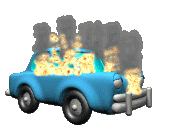
Vehicle fires are a very common sight. While fires in vehicles are frequent, they are usually put out very quickly, with minimal disruption to our daily lives.
The National Fire Protection Association calculates that fire departments respond to an average of 287,000 vehicle fires per year. These fires caused an average of 480 civilian fire deaths, 1,525 civilian injuries and $1.3 billion in direct property damage annually.
The statistic that seems hardest for most people to believe is that vehicle fires kill 480 civilians each and every year. Most adults can sit in the driver's seat and touch the windshield and three windows. How do we die in vehicle fires? In some cases, the crash may have rendered us unconscious. In other cases, the car is damaged and the doors are unable to open and the glass is tempered and may be laminated to make it stronger. If your vehicle is on fire, forget what is in the car and make getting you and your passengers out safely the only priority.
Although only 14 percent of the U.S. population is between the ages of 15 and 24, this age group accounted for a full 25 percent of the people killed in vehicle fires, giving them a risk of vehicle fire death nearly twice that of the general population. This group also had the highest risk of vehicle fire injury.
Looking back to when I was in that age group, the most important possession I had was my vehicle. I was more likely to take a chance on injury while trying to extinguish my car if it was on fire. This seems to be a “guy thing,” as nearly 80 percent of deaths and injuries in vehicle fires involved males. The point in all this is to make sure your driving-aged children know that vehicle fires are quite common, and if they are involved in a vehicle fire there are certain actions that need to be taken and discussed to lessen their chances of death and injury.
The first action involves safely pulling over to the side of the road where the car is not likely to be hit and the vehicle's occupants should be safe while getting out of the vehicle. Place the vehicle in “Park” and turn off the engine. Leaving the engine on can continue the flow of gasoline from the tank by the fuel pump. The next action is to make sure the occupants can get out. Once everyone is out of the vehicle, call the fire department to put out the fire. I have seen many people with burns on their hands who tried to open the hood themselves prior to our arrival. If there is a fire under the hood, it is a pretty safe bet that the metal nearby is also hot.
Stand well away from the vehicle while awaiting the fire department. It is common for bumpers and struts (used to assist in opening and keeping open the liftgates and hoods) to explode when exposed to fire. Many firefighters have been injured by this explosion.
Possessions aren't worth risking your life for. Vehicle fires are an inconvenience for us all, but far better to be inconvenienced than recuperating in a hospital bed.
Tom Kiurski is training coordinator for the Livonia Fire Department.
